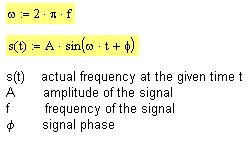Phase: Difference between revisions
m (+cat) |
|||
| (2 intermediate revisions by one other user not shown) | |||
| Line 1: | Line 1: | ||
==What is |
==What is Phase?== |
||
As a sinoidal signal in the time domain can be defined as |
As a sinoidal signal in the time domain can be defined as |
||
| Line 14: | Line 14: | ||
|[[Image:Phase2.jpg|signal with different phases]] |
|[[Image:Phase2.jpg|signal with different phases]] |
||
|} |
|} |
||
''Please have a look at the zero crossings!'' |
''Please have a look at the zero crossings! In the left picture the crossings are shifted to the right, in the right picture to the left hand side.'' |
||
Note: the phase can be either expressed as +/-Pi or +/-180deg. The signal itself can be described as cosine or sine, both is equivalent and up to you depending where you define time = 0. |
Note: the phase can be either expressed as +/-Pi or +/-180deg. The signal itself can be described as cosine or sine, both is equivalent and up to you depending where you define the time t = 0. |
||
[[Category:Technology]] |
|||
''should/can we type TeX? is this supported by our wiki setup?'' |
|||
Latest revision as of 22:29, 2 April 2005
What is Phase?
As a sinoidal signal in the time domain can be defined as
The signal phase describes an 'offset' of the signal along the time axis and defines the 'zero crossing' of the signal. An sinoid signal is periodic, therefore usually only phase values from +/-180deg (or +/-Pi) are used.
An Example
You see here an sinoidal signal with a frequency of 1kHz and an amplitude of 2 Volts. Time scale is -1msec..+1msec. The signal is shown with 3 different phases, from left to right:
- -60 degree
- 0 degree
- +60 degree

|
Please have a look at the zero crossings! In the left picture the crossings are shifted to the right, in the right picture to the left hand side.
Note: the phase can be either expressed as +/-Pi or +/-180deg. The signal itself can be described as cosine or sine, both is equivalent and up to you depending where you define the time t = 0.
